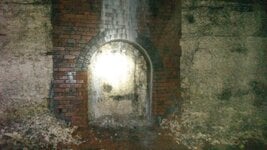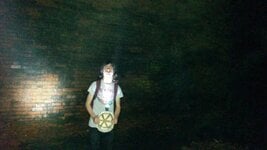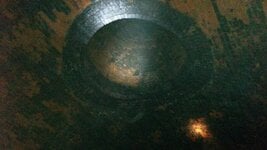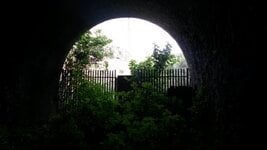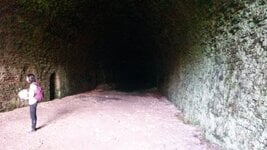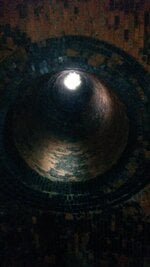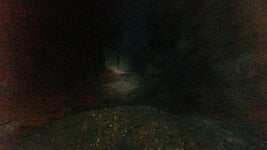After seeing antpant7's rookie report on this the other day, Squirrell911 and I decided that this one needed to be done asap.
We'd done Donington on Bain tunnel last week, but that was a baby compared to this one.
Thanks to antpant for access details, we could have wandered around for hours in the dark otherwise
Firstly here's some info on Drewton Tunnel -
The first goods traffic pressed the sleepers on 20th July 1885 with the passenger service welcoming customers a week later. One of the last substantial pieces of Britain’s railway jigsaw was in place.
The 12 mile section through the Wolds was a back-breaker and contributed significantly to the line’s steep average cost of £59,000 per mile. Cuttings and tunnels had to be excavated, but the area’s loose chalk proved difficult and frequent landslips occurred. More than 8,000 men helped build the line, living in camps and rioting regularly. The largest of these temporary communities - boasting shops and a mission chapel - was at Riplingham on top of Drewton Tunnel.
Hull-bound trains emerged from 2,116 yards of gloom at the line’s summit, whilst an 83 feet deep cutting - known by the navvies as ‘Big Hill’ - concealed their passage down the other side. Little Weighton sat proudly between these two immense achievements.
Like many tunnels, Drewton had a climate of its own. It could be very wet and perishingly cold. During the winter, icicles would form - often several feet long - and the first train through on a morning would collect a batch in its tender. One loco had its cab window smashed.
But a bigger shake-up was on the cards. Hull’s coal commitments were waning and, during the 1950s, British Rail hatched a plan to divert all remaining traffic over the easier NER route. The Hull & Barnsley’s decline was swift. Little Weighton’s passenger service bit the dust on 1st August 1955.
Through freight traffic ended in December 1958, marking the tunnel’s retirement. A shuttle service from Hull fed the coal yard until 1964 but, that summer, Little Weighton’s rail connection was finally severed, having survived less than 80 years.
Despite forty years of neglect, Drewton still exudes magnificence. Chalk-falls have almost engulfed one entrance but the eastern portal sits proudly at the head of its cutting, resisting encroachment by landfill. It’s a different story east of the village. Half-a-million cubic metres of household and industrial waste are slowly consuming Little Weighton cutting. Within a decade, all traces of it will be gone.
As I've already hinted, access is reasonably straight forward as long as you know where you're going.
So we scaled the frozen mud slide (it was a cold night) that almost fills the east entrance of the tunnel to the roof.
Once on the level we came across a long section that was only be described as one foot deep muddy clay.
There's no easy way of crossing this as I found out, ending up splashed with thick mud up to my waste

A suggestion for anyone attempting this - boots are a must, wellies would probably not stay on and waders might seem overkill but wouldn't be a bad idea.
So we were finally in and decided to walk all the way through and shoot on the way back.
It goes without saying that the more torchlight you've got the better, because it's as dark as it gets down there.
The One and a half mile long tunnel is evenly marked out by the large brick air shafts that lead to the surface.
As you'll see in the photos, the chalk has started to take over again in many parts of the tunnel; but other than that its reasonably structurally sound.
The West Entrance

The only sleepers left are in a pile under the 1st air shaft

Passing Arches - the only place in the tunnel with two side by side

Floor to Ceiling with Squirrell in the distance

The Chalk taken over again - this used to be all Brick

Staring up into the abyss - all the shafts are capped with a wooden cover

Leeds Uni have geological experiments in the tunnel - drip drip

Finally, tonights group shot

Before we knew it, we'd been in there three hours so called it a night.
Squirrells pics will follow this afternoon.
We'd done Donington on Bain tunnel last week, but that was a baby compared to this one.
Thanks to antpant for access details, we could have wandered around for hours in the dark otherwise

Firstly here's some info on Drewton Tunnel -
The first goods traffic pressed the sleepers on 20th July 1885 with the passenger service welcoming customers a week later. One of the last substantial pieces of Britain’s railway jigsaw was in place.
The 12 mile section through the Wolds was a back-breaker and contributed significantly to the line’s steep average cost of £59,000 per mile. Cuttings and tunnels had to be excavated, but the area’s loose chalk proved difficult and frequent landslips occurred. More than 8,000 men helped build the line, living in camps and rioting regularly. The largest of these temporary communities - boasting shops and a mission chapel - was at Riplingham on top of Drewton Tunnel.
Hull-bound trains emerged from 2,116 yards of gloom at the line’s summit, whilst an 83 feet deep cutting - known by the navvies as ‘Big Hill’ - concealed their passage down the other side. Little Weighton sat proudly between these two immense achievements.
Like many tunnels, Drewton had a climate of its own. It could be very wet and perishingly cold. During the winter, icicles would form - often several feet long - and the first train through on a morning would collect a batch in its tender. One loco had its cab window smashed.
But a bigger shake-up was on the cards. Hull’s coal commitments were waning and, during the 1950s, British Rail hatched a plan to divert all remaining traffic over the easier NER route. The Hull & Barnsley’s decline was swift. Little Weighton’s passenger service bit the dust on 1st August 1955.
Through freight traffic ended in December 1958, marking the tunnel’s retirement. A shuttle service from Hull fed the coal yard until 1964 but, that summer, Little Weighton’s rail connection was finally severed, having survived less than 80 years.
Despite forty years of neglect, Drewton still exudes magnificence. Chalk-falls have almost engulfed one entrance but the eastern portal sits proudly at the head of its cutting, resisting encroachment by landfill. It’s a different story east of the village. Half-a-million cubic metres of household and industrial waste are slowly consuming Little Weighton cutting. Within a decade, all traces of it will be gone.
As I've already hinted, access is reasonably straight forward as long as you know where you're going.
So we scaled the frozen mud slide (it was a cold night) that almost fills the east entrance of the tunnel to the roof.
Once on the level we came across a long section that was only be described as one foot deep muddy clay.
There's no easy way of crossing this as I found out, ending up splashed with thick mud up to my waste


A suggestion for anyone attempting this - boots are a must, wellies would probably not stay on and waders might seem overkill but wouldn't be a bad idea.
So we were finally in and decided to walk all the way through and shoot on the way back.
It goes without saying that the more torchlight you've got the better, because it's as dark as it gets down there.
The One and a half mile long tunnel is evenly marked out by the large brick air shafts that lead to the surface.
As you'll see in the photos, the chalk has started to take over again in many parts of the tunnel; but other than that its reasonably structurally sound.
The West Entrance
The only sleepers left are in a pile under the 1st air shaft
Passing Arches - the only place in the tunnel with two side by side
Floor to Ceiling with Squirrell in the distance
The Chalk taken over again - this used to be all Brick
Staring up into the abyss - all the shafts are capped with a wooden cover
Leeds Uni have geological experiments in the tunnel - drip drip
Finally, tonights group shot
Before we knew it, we'd been in there three hours so called it a night.
Squirrells pics will follow this afternoon.



